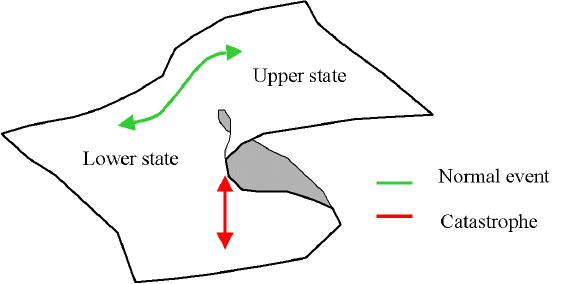 Just call me Sherman, Mr. Peabody's faithful pet boy who accompanied him on all of his trips in the Wayback Machine. Let me explain. My break from writing (although it is a bit pretentious to say "break" when you have made only one blog post) was due to a pending job change (thankfully of the Robert Frost-type). In going through the process of packing books, an old pair of texts I had read years ago on Catastrophe Theory caught my eye, one by Arnol'd and one by Gilmore.
Just call me Sherman, Mr. Peabody's faithful pet boy who accompanied him on all of his trips in the Wayback Machine. Let me explain. My break from writing (although it is a bit pretentious to say "break" when you have made only one blog post) was due to a pending job change (thankfully of the Robert Frost-type). In going through the process of packing books, an old pair of texts I had read years ago on Catastrophe Theory caught my eye, one by Arnol'd and one by Gilmore.I had just finished Fooled by Randomness by Taleb and traveled a few pages into his second book, The Black Swan: The Impact of the Highly Improbable
One of the concepts that Taleb stresses is his "triplet of opacity", which he defines as
- an "illusion of understanding", where individuals believe that they comprehend the world more than they actually do
- "retrospective distortion", or the proverbial adage "hindsight is always 20/20"
- "overvaluation of factual information", or the curse of knowledge
 Starting with the work of mathematician Rene' Thom, catastrophe theory describes a geometric interplay between small changes in parameters in nonlinear systems that lead to sudden, large changes in the system. The figure to the right is a cusp catastrophe, and think of the green arrow as the path of a single, known parameter. Movement in the direction perpendicular to that parameter (toward the front of the figure) is due to an unknown parameter. As long as that unknown parameter is in the back of the figure, the system behaves as described. But once that parameter passes the start of the cusp, that smooth transition due to changes in the known parameter becomes a black swan, the system rapidly falls from the upper state to the lower state along the red path. Easy example...you are turning the volume knob up and down on a stereo for a time, enjoying the rising and falling of your favorite song. The knob setting is the known parameter, and the system state is the volume. The unknown parameter is a small child hiding behind the stereo, fighting temptation to pull out the plug. When he does, the system fails and to you (still not seeing the child) it looks random...a black swan...a catastrophe.
Starting with the work of mathematician Rene' Thom, catastrophe theory describes a geometric interplay between small changes in parameters in nonlinear systems that lead to sudden, large changes in the system. The figure to the right is a cusp catastrophe, and think of the green arrow as the path of a single, known parameter. Movement in the direction perpendicular to that parameter (toward the front of the figure) is due to an unknown parameter. As long as that unknown parameter is in the back of the figure, the system behaves as described. But once that parameter passes the start of the cusp, that smooth transition due to changes in the known parameter becomes a black swan, the system rapidly falls from the upper state to the lower state along the red path. Easy example...you are turning the volume knob up and down on a stereo for a time, enjoying the rising and falling of your favorite song. The knob setting is the known parameter, and the system state is the volume. The unknown parameter is a small child hiding behind the stereo, fighting temptation to pull out the plug. When he does, the system fails and to you (still not seeing the child) it looks random...a black swan...a catastrophe.Now my mind is wondering about the structure of things, especially in biology. Does the start of cancer live in the cusp? Is the quiet accumulation of mutations that "unknown parameter" that silently slides toward the cusp? The human body is a complex system, that is only partially understood...
No comments:
Post a Comment